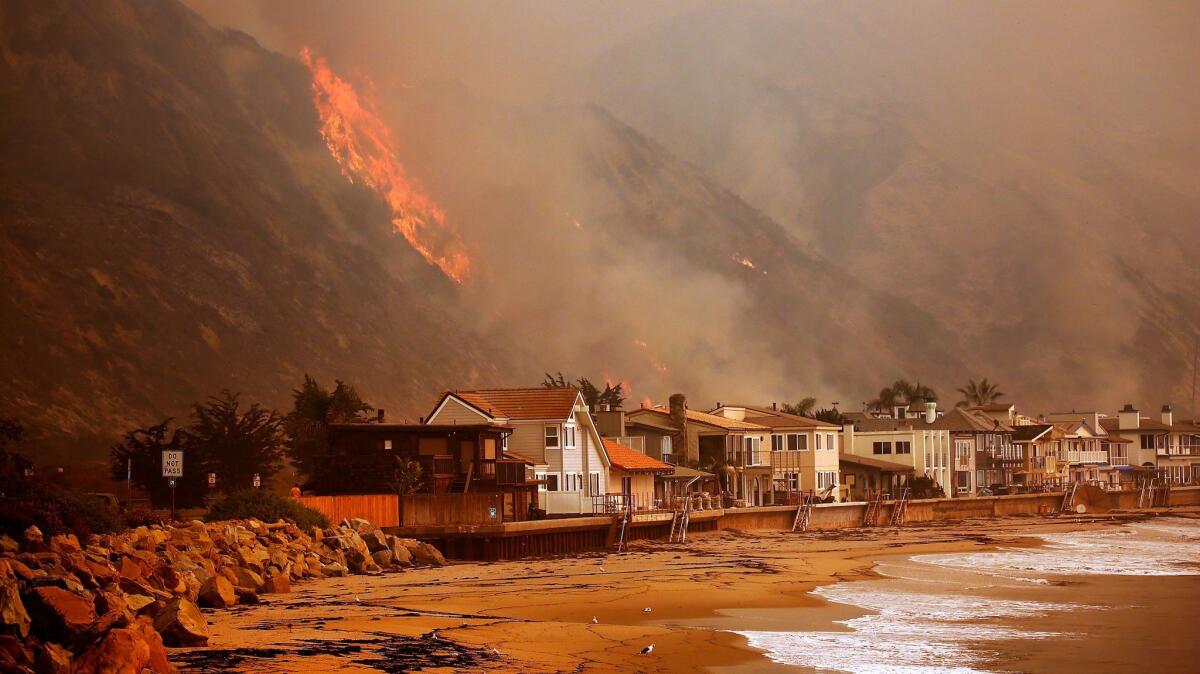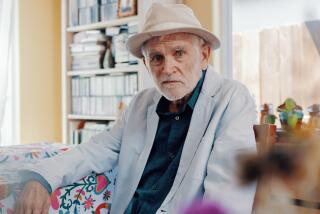For American cities in 2017, flood, fire and volatility became the new normal

- Share via
It has been a year of flood and fire for the American city. In late summer, Houston virtually disappeared under water as Hurricane Harvey dumped a total of 33 trillion gallons on U.S. soil. Not long after, with the deadly wine-country fires barely out, Los Angeles, Ventura, Santa Barbara and San Diego counties caught fire, burned and kept burning. The Thomas fire, which started near Santa Paula, is now the fifth largest by acreage in California history — and within shouting distance of the biggest ever.
In a certain sense these disasters seem familiar, or at least regionally appropriate. Houston, a city whose bayous thread through its neighborhoods like veins, is fundamentally a wet place. Los Angeles, accustomed to bracing for fire as soon as the Santa Anas begin to blow, is fundamentally an arid one — if not quite “a desert that faces an ocean,” as Carey McWilliams put it with slight exaggeration, then certainly a landscape that spends each year getting drier and more flammable as the months pass.
FULL COVERAGE: Year-end entertainment 2018 »
What’s changed is the numbing regularity of these events, the way they crowd together on the calendar in much the same way wildfires have been crowding together on the map of Southern California in recent weeks. (And the way they spread out on the calendar too: It used to be the case that by December the Santa Anas were done for the year. This year they revved up just as Angelenos were pulling boxes of Christmas lights from the attic.) Thanks to the combination of climate change and several decades of American overconfidence about planning and land use, we’re on the doorstep of an era when dramatic disasters, floods and wildfires chief among them, threaten to become routine.
What do I mean by “overconfidence”? I mean that in nearly every corner of the country we have expanded our metropolitan regions into the path of, instead of away from, risk. Houston has for many decades seen nearly every flood plain as developable. Los Angeles has had the same attitude about many hillsides and canyons — even some that have burned again and again for centuries on end.
That attitude is the flip side of American pragmatism. A can-do spirit can be a death sentence when the thing you’re getting done is environmental folly. And the risks are simply higher now. One recent study found that hurricanes as strong as Harvey are three times as likely in the age of climate change as before; another estimated that climate change had increased that storm’s rainfall by 38%. California’s five biggest wildfires have all taken place in the last 14 years.
In an odd way we’ve already begun to adjust. One remarkable aspect of the recent wildfires has been the expectation among people in other parts of the country that with so much territory on fire and so much smoke in the air, life in Los Angeles must have come to a standstill. In fact, especially in the parts of the city east of big smoke plumes, life went on under blue skies and in pleasantly though not exceptionally warm temperatures. The fires barely put a dent in our routines.
On Labor Day weekend of 2005, less than a year after I started working as architecture critic for The Times, I flew to New Orleans to cover the aftermath of Hurricane Katrina. I spent my nights there sleeping on the floor of a neon-lit sports bar inside the Hyatt Regency, the only big hotel in town with power.
For all of New Orleans’ history of flooding, there was something that seemed exceptional about that disaster: about its scale, about the way the eye of the hurricane, instead of skirting the city as had happened so many times before, this time seemed to steer itself right toward the Superdome. It seemed a water-driven equivalent, in a certain way, of 9/11: a once-in-a-generation, or even once-in-a-lifetime, jolt to the regularity of city life.
I was wrong to see it that way, of course. Even within a couple of days of exploring New Orleans, my tattered and dog-eared copy of Peirce Lewis’ seminal “New Orleans: The Making of an Urban Landscape” under my arm, it became clear that much of the destruction in and around the city was an example of urban-planning chickens coming home to roost. Beginning with the invention of a new pump in 1913 that made it possible to drain the swampy neighborhoods between the heart of New Orleans and Lake Pontchartrain, the city built aggressively in long-empty terrain. It made its housing stock absurdly vulnerable to the very flooding for which the city, much of which lies below sea level, has been famous since its founding.
To compound the effect of disasters and how we understand them, volatility is increasing in nearly every part of contemporary life. The chaos of flooding and fire is now redoubled by the chaos of the media and political landscapes. How do you make sense of the culture when the exceptional morphs into the predictable?
Last week, for example, all of the following things happened within a single 24-hour news cycle. A would-be suicide bomber, reportedly inspired by ISIS, tried to blow himself up in Manhattan. Mario Batali, a chef, and Ryan Lizza, a journalist, were the latest prominent men to be accused of sexual misconduct. Ed Lee, the mayor of San Francisco, died suddenly of a heart attack at age 65. And Alabama voters got ready to head to the polls in a wild special election for U.S. Senate — a race featuring a Republican candidate whose Svengali, Stephen K. Bannon, promotes a political philosophy that has been aptly described as “maximum chaos.” As all of this was going on the seemingly inexhaustible Thomas Fire was creeping over some very dry hills and bearing down on the town of Carpinteria.
A few days earlier that fire, which began about 10 miles inland, reached the ocean near Ventura’s Solimar Beach. That seemed a perfectly chilling way to mark the end of 2017. Fire, chewing up earth and fueled by fast-moving air, meeting water. The four classical elements all working together in service of Disaster, new patron saint of our increasingly vulnerable metropolitan regions.
SIGN UP for the free Essential Arts & Culture newsletter »
christopher.hawthorne@latimes.com
Twitter: @HawthorneLAT
More to Read
The biggest entertainment stories
Get our big stories about Hollywood, film, television, music, arts, culture and more right in your inbox as soon as they publish.
You may occasionally receive promotional content from the Los Angeles Times.











